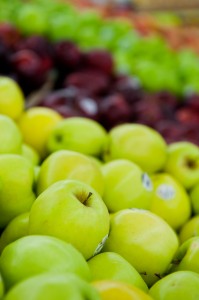Fruits. Vegetables. Whole grains. Are these vital foods a part of your college diet?
Life as a college student is busy, overwhelming and for most, a strain on the the pocketbook. As a result, students find themselves refueling on fast food and other cheap foods full of carbohydrates and fat. Eating healthy on a college budget can seem impossible, but it can be easily achieved if an effort is put in.

The answer is not in turning to cheap fast food, but in planning ahead to buy a balanced meal for a fair price.
Dr. Lora Beth Brown of the BYU nutrition department said the best place to buy cheap, healthy food is the grocery store. Brown said making homemade meals takes a little time to put together, but is worth it in the long run.
If students know what foods to buy and where to buy them for a good price, they can keep their bank accounts full while giving their bodies the nutrition they need. A majority of fast food restaurants do not offer what is needed for a balanced diet. Purchasing ingredients at the grocery store and spending a little time preparing food can make a huge difference. Dr. Pauline Williams, also of the BYU nutrition department, had some great ideas for saving money on healthy food.
“The healthiest cheap foods are dried beans,” Williams said. “They take some time to cook, so you must plan in advance. You can buy them in a can, but they are cheaper if you buy them dried.”
She recommended cooking them in bulk with a crock pot. They can then be frozen and warmed up as needed to eat throughout the following weeks. She also recommended buying milk when it is on sale, and only buying the quantity of milk that will be used, saving students from wasting money on milk that quickly spoils.
Doing this may take some effort, and healthy foods are usually more expensive than less healthy foods; however, the money and time are well worth it. Ian Ray, a health-conscious BYU student, said he spends about $50 every two weeks stocking up on healthy foods at the grocery store. He gets ideas for meals from outside sources.
“My favorite meal has to be taken from Instagram Fitness on Instagram,” Ray said. “It is a community of health and fitness addicts who love to post workouts and healthy, filling meals for breakfast, lunch and dinner.”
Ray also said in order to save money for breakfast he eats a bowl of oatmeal with fruit and a side of bread and jam. For lunch he eats a simple tuna or egg sandwich with carrots or a salad. Dinner often consists of veggies and protein, sometimes accompanied with rice or a whole grain pasta.

In addition to planning meals, Ray recommended eating fruits and vegetables. He said they are a great source of vitamins, minerals and fiber.
Williams also said most college students do not eat enough fruits or vegetables, even though incorporating them into a diet is surprisingly easy. They should be added to the grocery list and kept readily available for eating at all times. Students can make a “to go” fruit smoothie in the morning or grab an orange on the way out the door.
“Eat more fruits and vegetables,” Williams said. “If you look at the research, at what is helpful in weight management and reducing the risk for cancer, the answer is almost always eating more fruits and vegetables.”




